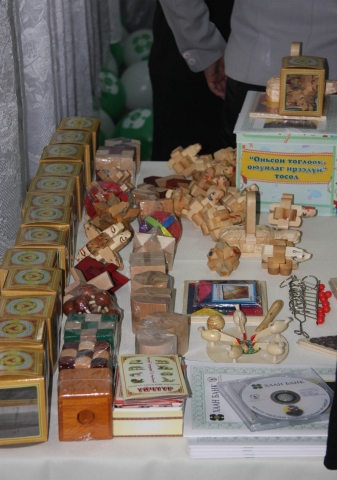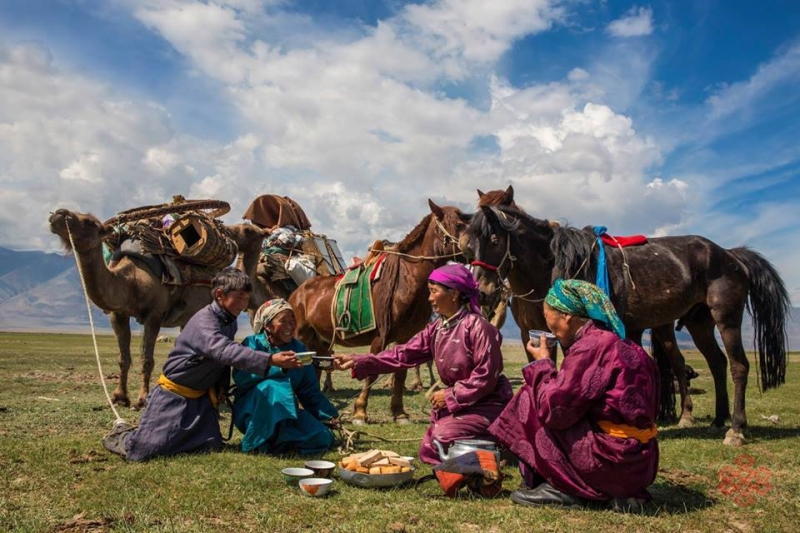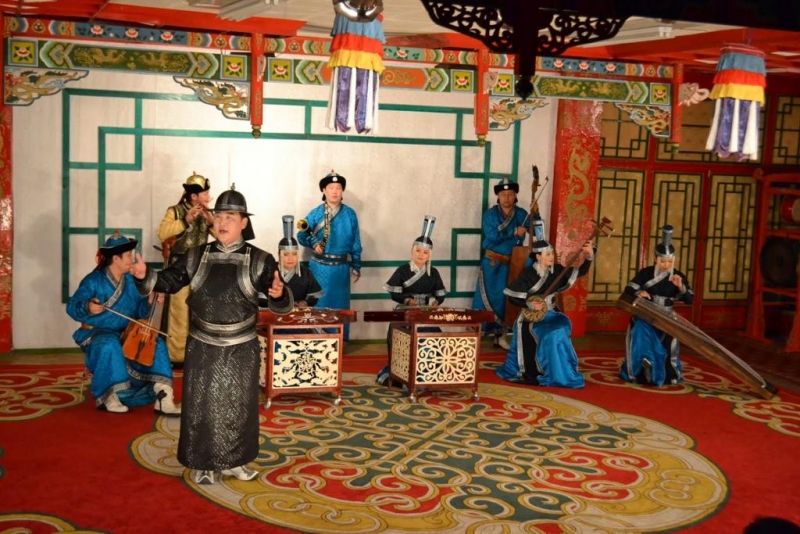CULTURE AND HISTORY
Mongolian traditional games can be divided into 2 general types on the basis of their general form; games which are played using simple and readily-available materials such s stones sticks, or animal bones and games which are played using objects created by the artistic means; namely with painted or carved pieces. The games of the one category are characterized by a close figurative connection with nature and the herding lifestyle, often having a ritual of symbolic element to their playing & by a relative simplicity of their rules of play. The games of the latter category- which include cards, chess dominoes and interlocking puzzles -are symbolically associated with social and artistic activities and are usually more sophisticated requiring greater intellectual skill in their playing. Of the games played with really and natural materials, the simplest is "ail ger" (family home). The game is played with stones, much in the same way as children in western countries play "house" with dolls a small circle of stone is set up to represent a ger; further stones are placed inside it to represent furniture and house hold objects and stones of different shapes and colors are collected outside the home to represent the families herds. The most unique Mongolian game is shagai or anklebones, which as the name suggests, is played using the cleaned and polished anklebones of sheep. Each of the four sides of the anklebone represents a different animal; horse, sheep, camel, goat, although there are many games which can be played with the bones. In earlier times, families which managed to collect more anklebones than they needed would select an auspicious day and go to play the game of "multicolored turtle" on the top of a mountain leaving the bones afterwards as an offering to the mountain or to the sky. This game is played with a number of bones corresponding to one of the auspicious number in the Buddhist faith- most often 81 or 108. the placement of the bones represents the five elements and colors in addition to the body of the turtle itself, which is viewed in traditional Mongolian iconography as the symbol of the cosmos players take bones from different parts of the turtle or surrounding five elements on each turn corresponding to the throw of a die. Once the players have collected all the parts of the turtle's body the game concludes with the player in possession of the most bones the winner. One of the common games played with shagai is the "horse race" for 2 or more players. Games played using carved or painted pieces include cards, chess, dominoes and khorol (a game similar to dominoes, using the 12 animals of the zodiac and Buddhist symbols). Of these games chess remains one of the most popular as well as one of the oldest traditional games some Mongolian scholars claim that chess sets characteristically depict nobles, horses, camels, oxcarts and other identifiable elements of Mongolian life. Mongolian chess is more similar to the European than the Chinese version of the game, but there are several important differences in the rules for example: only the pawn in front of the Queen is only permitted to move one space at a time when moving diagonal.
Mongolia is one of the nomad countries in the world. Since the Hunnu Empire Mongolians raising their five domestic animals (it is including sheep, horse, cow, camel, and goat) in the broad region of forest, steppe and Gobi desert. Especially they respect their horses. Mongolians see their horse is their best friend. Mongolian nomadic people move into place to place 2-4 times a year as well as it is depending on livestock's pasture. Mongolian nomad people always following their livestock. Because livestock knows where is the best pasture? Herders live in Mongolian traditional dwelling (covered felt) Ger.
Mongolian five animals.
Mongolia is the land of livestock. Now in Mongolia has over 55.9 million livestock, including 24.9 million sheep, 23.6 million goats, 3.8 million cattle, 3.3 million horses and 367.9 thousand Bactrian camels.On these give animals depends the prosperity of the country. All flocks of sheep include goats, only shepherds can really explain why. The sheep provides meat, wool and leather, nowadays its milk little taken. The goat provides milk and company for the sheep, its fresh is seldom eaten. The cow is eaten and milked, and its hide provides leather often the yak is used instead of the cow, or else together with cattle. The she- yak's milk is fatter. The yak seems more active than the cow, and as one approaches a mixed herd, the yak's - hairy as terriers - are always the first to run off, lofting their- feathery tails like pennons. Also there is hainag, a yak cow hybrid. (The reverse hybrid, from a Mongolian bull with a female yak, is possible, but not used.)The male hainag is strong, stronger than either parent. It is burly beast with hair longer than its mother's and shorter than its father's. The female produces more milk than the female of either parental stock. But its calf, the ortom, is a weakling, and breeding is not taken other. The horse is kept as a mount and for milk. Mares must be in foal a great part of the year. Several times in journey you will come across twenty or thirty horses crowded, noses together close to Ger They are waiting their turn for milking. Mongols say they milk better if you let the foal start them.The means of transport is the camel. His wool warm to the rider, is taken also. But he is not eaten, nor his female milked, save perhaps on the edge of the desert where no other livestock viable. Camels are formidable. The males, when their minds are on mating, foam at the mouth and fight. Camel herds are usually smaller than those of other animals. Camels and coats are shorn but once a year. Sheep sometimes twice. A Mongolian sheep gives three or four pounds of wool a year.
Yellow headed Buddhism began to enter into Mongolia from Tibet the second half of the 16 th century. Since that time mostly Mongolians believe Buddhism. But Mongolian Buddhism is different from Tibetan Buddhism. Mongolian Buddhism connected with Mongolian traditional lifestyle. Before in 1930 40% of male population was lamas (monks). Between the communist purges 1930-1940 Russian and Mongolian soldiers destroyed about 700 monasteries and temples. Until in 1990 any religion closed in Mongolia. After democratic movement in 1990 all religion reopened. In 2002, there are about 180 religious temples and churches operating in Mongolia and more than 110 Buddhist monasteries and temples and about 70 Christian churches in Mongolia .
Buddhism: Buddhism in the form of the yellow hat Buddhism or Lamaism making further inroads into Mongolia from the second half of the 16 th century. According to the Mongolia Buddhist doctrine, it is said that the sky father blessed all of the world and that there is one who could say, I am a owner of the world' Buddhism teaches the 'nature of reason' and that if good deeds are done, they will have good results. Similarly if bad deeds are done, they will have bad results. Buddhism preaches about these as 'ten black deed sins' and 'ten white deeds'. Sins are divided into deeds which are made with the body with speech or with the mind through thoughts. Sins made with thoughts include thinking about bad things having evil thoughts, corruption, intentionally or purposely doing a crime, planning aggressive war, and so forth.It is said that Buddhism believes that thought is thing prior to both body and speech. They consider evil thoughts the result of numerous sufferings and unavoidable accidents and misfortune. The term used for such negative feelings is Nirvanas (greed, anger, opposed, ideology). Buddhism argues that if we can systematically remove these strong desires or greed from the mind we can become wholly enlightened people. With enlightenment, thoughts will become pure and clean and reach to the height of bliss.
Odes to nature, horses and the open steppe are popular themes of traditional Mongolian music. Long songs, as the name suggest have lasted a long time and are loved by Mongolians. The original long time and written about 800 years ago and there are special songs for weddings, festivals and religious ceremonies. Traditional Mongolian instruments include string and wind instruments, drums and gongs. Mongolians have made their music instruments through the ages using metal, stone, bamboo, leather and wood. The most popular instruments is the "Morin khuur" -Morin Khuur ( horse headed fiddle ). It is a square fiddle with the long, straight handle curved at the tip and topped with the carving of a horse's head. It is said to represent the movement and sounds of a horse. Every Mongolian family strives to have a morin khuur in their ger even though they are hand-made and fairly expensive instruments. In the beginning it was simply a ladle for airag on which strings were strung. At that time the instruments was called "shanagan khuur" (shanaga is ladle or dipper). Later the sounds and board took the form of a trapeze and the master carvers who made these popular instruments began to decorate them with whimsical figures. Then the head of horse, an animal greatly loved by all Mongolians, appeared on the neck, and the name was changed to morin khuur. Twelve animals are carved on the neck in accordance with twelve years cycle of the lunar calendar. The morin khuur has two strings and bow made from the hair of horse's tail. At the top of the morin huur's neck is a horse's head, but here too, there are 5 other animals -horse, camel, cow, sheep and goat, Mongolian symbols of wealth and plenty. The morin huur is most suitable to accompany the traditional long and short songs and Mongolian classical dance bielgee. Last year our president declared 'Morin huur is our state instrument" so government founded Horse headed fiddle orchestra. In 13 th century Mongolia had those kinds of famous orchestra. Usually Mongolians use the horse headed fiddle; Naadam, white onth, wedding and other big ceremony.
Legend about Morin khuur, national instrument
It has ancient origins and is purely Mongolian musical instrument. Once upon time there was a poor man. He had a wonderful steed. The horse was a special one; it was faster than bird and could instantaneously cover great distances. But one day he found his horse dead near his ger. So his heartbroken, he began to make a fiddle from his horse's bones, tendons and hair. Then he fixed the horse's head to the handle and overcome with grief, lay his own head on it to unite himself spiritually to his dead friend. So he started to playing the Morin huur describing his beloved steed's steps, gallop, hurdle, trotting, and neighing. Thus goes the ancient legend of the illians about the origin of the morin huur.






.jpg)


